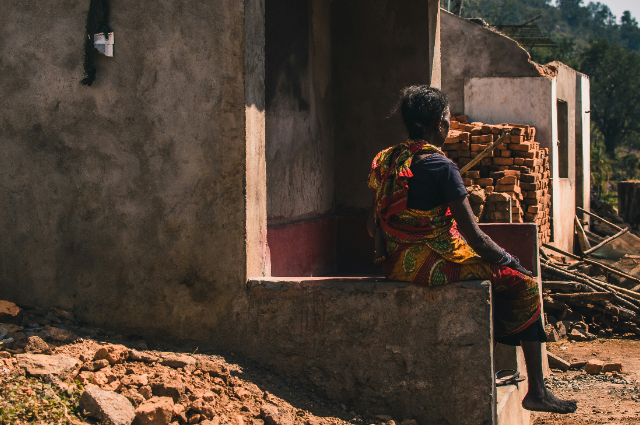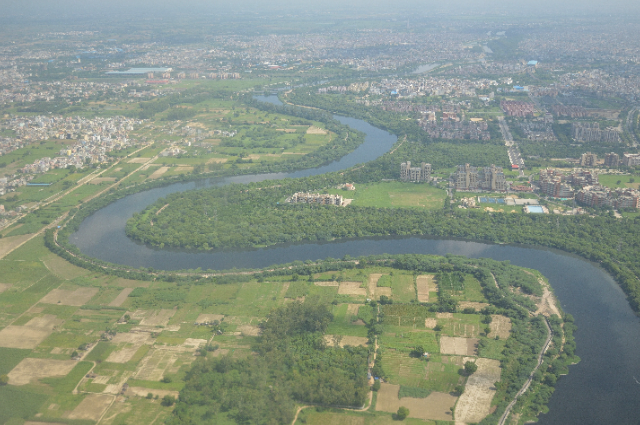"Uparwala karta hai sabka, ham toh kon hai. Bhagwan sab dekhta hai...", said the elderly woman, in an unfinished house, bricks on the doorway, children playing near us.
This is the story of the people, unseen by the government, unseen by the "normal" people, unseen even when in front of our eyes.
That is why “Invisible People”, if you have questions regarding the title, thinking this is about aliens or extra-terrestrial beings.
Last month and in the May of this year, I, alongside my group of batchmates, decided to film a documentary on the topic of "De-notified Tribes". We met people belonging to some communities under these tribes, visited the locations and witnessed the problems faced by them. Not just basic requirements such as amenities, sanitation, and housing but also the societal identity and respect are almost non-existent for these people.
When you have no idea about something, you don't know something like that would even exist.
This is the story of Najafgarh.
Introduction

Photo by Parij Borgohain on Unsplash / Representative Image
The People
The term “De-notified Tribes” stands for all those communities which were once notified under the Criminal Tribes Acts, enforced by the British Raj between 1871 and 1947. These Acts were repealed by the Independent Indian Government in 1952, and these communities were "De-notified". A few of these communities which were listed as de-notified were also nomadic.
Terms such as nomads and semi-nomads are applied to 'social groups who undertook a fairly frequent, usually seasonal physical movement as part of their livelihood strategy in the recent past. The term semi-nomad is mostly used to describe those sections of nomads whose duration, distance and frequency of movement are comparatively less than others. The distinction between nomads and semi-nomads does not involve distinguishable ethnic categories or social groups, it rather describes the degree of mobility practiced by them.
The Place
Najafgarh is a town in the South West Delhi district of the National Capital Territory of Delhi, India. It is one of the three subdivisions of the Southwest Delhi district. Najafgarh is located in south western part of Delhi sharing its territory with Gurgaon and Bahadurgarh, Haryana.
We visited two locations in the town of Najafgarh, Dharampura Basti and Perna Basti. The locations are near the Dwarka and Dhansa Bus Stand metro stations.
The people of Najafgarh
The identities of the people we talked to, will remain anonymous in this article, as requested by them. We asked each one of them, permission regarding their identities and to show their faces on camera for the documentary, and have neglected to name anyone of them.
The two locations we visited, in the given order are:
1. Dharampura Basti:
Near the metro station of Dwarka, around 6 kilometres into the small township of Dharampura, reside hundreds possibly thousands of people from the “De-notified tribes”.
The location was not as bad as I imagined. The living conditions were fine for the most of it, some houses were not complete. But it was only the outer layer of this rotten coconut. We met with people who did not have Aadhaar Cards, identification documents for every citizen, no matter their background. One lady confirmed, that the nearest Aadhaar centres were asking for a hefty amount of ₹10,000.
There was a house, when we were talking to the people around the place. It was a small house, I don’t think you can even call it a house, as it was just the size of a very small local general store. The people living in that house told us, that around 20 people live in that house, their family.
Some locals also confirmed that child marriage was also common in their community, as one man, 23 years old, married at the age of 19 had 3 children, but they were not in the favor of it. One person belonging to the Perna community, also told us that his mother was prohibited from sitting on a chair or sofa or bed, while his wife, also belonging to the same community was allowed to.
Dharampura was only the initial stage of our experience. What lied ahead was more complex and a bit disturbing to learn about.
2. Perna Basti:
Near the metro station of Dhansa Bus Stand, around 4 kilometres into the slum area of Perna Basti, a place named because of the so-called infamous community amongst the “De-notified tribes”, Perna.
The Perna community has a history of women engaging in the acts of prostitution. The wives, daughters, and mothers belonging to the families of this community work as prostitutes to make a living. They did it even decades ago and they still do.
We met with people who viewed people from this community as “impure” and making the place “impure”. An ice cream seller there himself said, he does not associate himself with Pernas and was “pure” or “swachh” as he said it.
The living conditions were not “pure”, not what the people meant, as the roads or paths were non-existent. As sludge and garbage filled the roads, transportation is a difficult task to do.
Experts
We met with two experts on this subject matter and interviewed them to gain more knowledge regarding this topic. One being a member of the National Commission for Protection of Child Rights (NCPCR) and one being a lawyer associated with them. Both of these experts confirm the problems as well as the information provided by the people belonging to the tribes. Their opinions regarding this matter were critical about the government’s actions towards the situation of these communities.
My Thoughts
For me, this was an eye-opening experience, truly. We all can never know everything, about everything. And I am thankful to be a part of the documentary and I am truly grateful to have met with the people of Dharampura and Perna bastis, as I would have never known about the people and the conditions that they have to live in.
I, as an individual, cannot bring a swift change in their conditions or the current working of the system. It is not an easy task, that I agree with, but I always remember Mahatma Gandhi’s quote:
Be the change, you wish to see in the world.
Having met with all the people, the children, the women and everyone belonging to the places and communities, I have understood that people around us are neglected by us, even if that is not our intention. One thing I believe I have changed is that my judgement of the people around me.
Whenever the cleaning helper comes in the morning, I always tell my mother, “Kuude wala aa gaya”. And my mother always replies, “Kuude wala nahi, SAFAI WALA. Kuude wale toh ham hai”. Never have these words touched me, more than now. The helper may not belong to these communities, but it is our perception of them, that they are the ones that can touch waste only. Why? They never dreamt of doing that, they never thought about taking our garbage and making it their livelihood. People never dream about doing something they don’t like, the situations, the circumstances lead them to this way.
It is a simple thing, a very common thing for us. But it is an important one, a perception, a public opinion can change the waves of times. What we can do, what is in our hands, is to create a better perception. To see things not just from our own perspective, but also from theirs.
As for our documentary, titled the same as this article, if anyone who reads this article, who might tend to watch the documentary, can access it through this Drive link: drive.google.com
I worked on the documentary as the cinematographer and camera person, so for me, it was also a learning experience professionally.
Conclusion?
This is just one story, about this tribe, about one location in the nation's capital, about a handful of people suffering from the problems.
Yet, a smile on their faces. A hope in their eyes, every day when they wake up, they try to do better, to do more, for themselves and for their dear ones.
There is no conclusion to this story, as there is no end in the journey of the tribes that are unseen.
A question may arise: What can we do for them?
Respect. Treat them how you treat your family, is what one can do. Monetary help or providing shelter or clothing to them only leads for them to believe that is the only way of surviving in the society, which leads to path of being beggars.
Everyone in the world deserves to be happy, no one deserves to be hurt. As is the case of them, they are not different from us, they laugh, cry, fight, talk, eat in the same way as the "normal" people do. The tag of "De-notified" has not just kept them under the shadows of being unworthy of everything, but has also created an image of "different" for them.
I do not believe that India is the greatest nation in the world. But I do believe, is that we have the power to become the greatest among all. To create and nurture a place where people believe that death is their only salvation. Life is greater than suffering, greater than death.
Not today, not in these present times, but I do believe with all my heart, that one day, when the walls of hatred and discrimination will fall down, that day. The people of Najafgarh and all the people from the tribes from all places we might not know about now will stand proudly, as well as everyone from this nation of courage, color and craft.
One day, the invisible will be seen...

